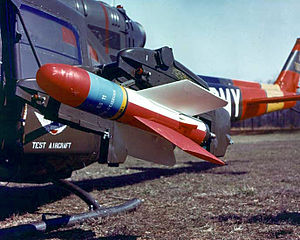Nord SS.11
| SS.11 | |
|---|---|

SS.11 at the U.S. Army Redstone testing ground
|
|
| Type | MCLOS wire-guided anti-tank missile |
| Place of origin | France |
| Production history | |
| Designer | Nord Aviation |
| Designed | 1953 |
| Produced | 1956 - mid 1980s |
| Number built | 180,000 |
| Specifications | |
| Weight | 30 kg |
| Length | 1190 mm |
| Diameter | 165 mm |
|
|
|
| Effective firing range | 500 m to 3,000 m |
| Warhead | Type 140AC anti-armour |
| Warhead weight | 6.8 kg |
|
|
|
| Wingspan | 500 mm |
| Speed | 190 m/s |
|
Guidance
system |
MCLOS |
| Nord SS.11 | |
|
|
|
|
|
|
|
|
|
|
|
SS.11 is the designation of the Nord Aviation MCLOS wire-guided anti-tank missile. In American service the missile was designated the AGM-22. The missile entered service with the French Army in 1956. Production of the SS.11/SS.12 series ceased some time in the 1980s; but in 1978 168,450 missiles had been produced. The price of the SS.11 in the late 1960s was stated at approximately $1,900 US dollars.
Development of an improved version of the SS.10 (Nord-5203) began in 1953 as the Nord-5210. The missile was intended as a heavy version of the SS.10 for use from vehicles, ships and helicopters, with even an infantry version developed later. The missile entered service with the French army under the designation SS.11. It was used as the first helicopter-mounted anti-tank missile in the world (on Alouette IIs).
From 1962 a "B" model of the missile was produced, which replaced some of the original electronics with solid state components. The transistorisation provided improved handling, which allowed the missile pilots to over-correct less. This was the version used for development of an infantry version, in which the operator carried three warheads and had a "waist belt fire-control," and three other men carried the missile minus its warhead.
One of the most unusual uses of the SS.11 was that of probably the smallest anti-shipping missile in the world, with the Swedish Marines employing it in the anti-landing craft role for decades, until it was replaced by a specialized version of the AGM-114 Hellfire. It was also used by the Finnish coastal artillery for covering narrow channels in the archipelago, being replaced in this role by the Israeli SPIKE ER (Rannikko-Ohjus 06).
The first combat use of the SS.11 was in 1956, being fitted as an experiment to an MD 311, an early version of the French Air Force Dassault MD 315 Flamant light twin-engine transport in the Algerian-French conflict, as a method of attacking against fortified caves located in steep mountain gorges. The combat experiment proved extremely successful and became standard on other French Air Force MD 311s stationed in the Algerian war theater. From this early combat experience in Algeria with fixed wing aircraft firing the SS.11, the French Army took note and introduced the world's first specialized combat helicopter firing antitank missiles, based on the Alouette II and later the Alouette III that fired both the earlier surface-to-surface SS.11 and the AS.11 developed for air-to-surface firing from aircraft, both of which saw extensive combat in that conflict from 1958 to 1962.
...
Wikipedia
